Been in a new car showroom lately? You’ll be hard pressed to find a lowly incandescent bulb in so much as a dome light. The same is true for new aircraft. Not many are sporting old-school filament lamps for landing, taxi and position lights. As a byproduct of an avalanche of LED manufacturing, we’ve found more applications for these lamps than ever for legacy aircraft.
If you can’t find the exact replacement for that old GE burner in your wing mount, stick around. It’ll be along pretty soon. And the new products are brighter and more efficient than the previous versions and in many cases, they consume less power than first-gen LEDs did.
What they are not, however, is cheaper. For all their advantages, even the least expensive LEDs are still many times more expensive than the incandescent bulbs they replace. Although the manufacturers claim—and can support—that LEDs are basically lifetime bulbs, the $400 for a LED equivalent of a GE4509 will still buy more than 60 of the incandescents. Some owners, understandably, find the economics underwhelming.
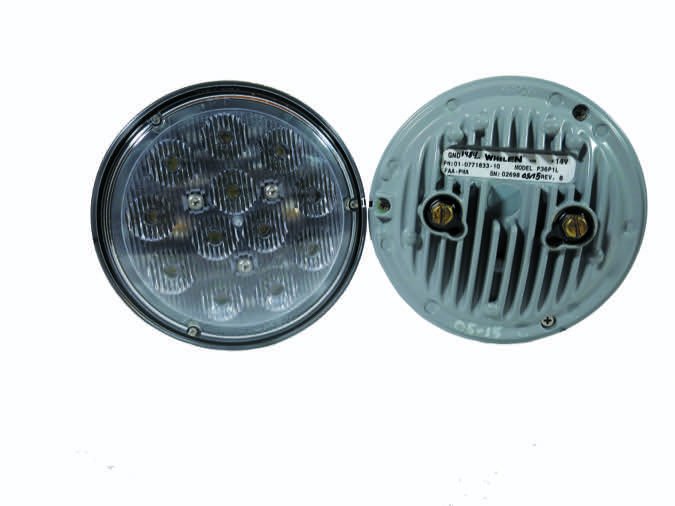
Trends
Nonetheless, the aviation LED market is enjoying significant traction, with new products and applications appearing almost monthly. In fact, there are now so many offerings that testing them all has become a logistical impossibility. For this article, we’re scanning the market’s new products with an eye toward brightness measuring in a future article.
As in the LED industry in general and especially automotive, the overarching trend is more efficient LEDs with each new product cycle. As recently as a decade ago, we wondered if LEDs would ever be bright enough to be landing lights. No more.
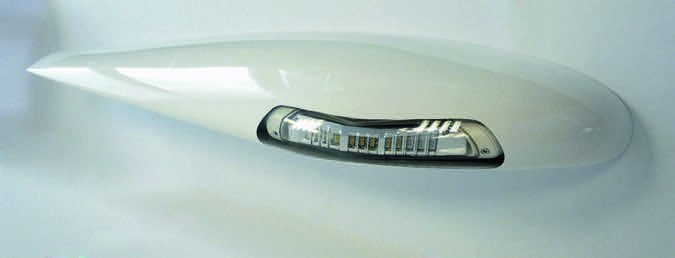
“When we first started, LED efficiencies were in the range of 60 to 80 lumens per watt,” says Dean Wilkinson of AeroLEDs. “Now, 120 to 150 lumens per watt is pretty
common. So there’s been a doubling of efficiency in the last eight years, probably. In the next eight years, you’re probably going to see another doubling,” he adds. Is this going to go on forever, to the point where a landing light can run on an AA battery? Probably not. “There is an upper limit. I think 200 lumens per watt is about it. Six hundred lumens per watt is 100 percent efficiency and that’s not really possible,” Wilkinson explains.
Not that what we’ve got is too shabby now. Our tests show that even the last generation of LEDs easily outshone standard GE incandescents. Color temperatures closer to daylight also means they create more contrast to illuminate details on runways and taxiways. Newer LEDs are either brighter or the same brightness at lower current draws. This changes the product development map.
“If you get the current down for the same light, or keep the current and get a lot more light, you’ve got room to play,” Wilkinson says. As a result, look for more products that leverage the advantages of LEDs.
One of these comes from Aveo, a company that positions itself upmarket and has facilities in Florida, eastern Europe and India. The company’s LED line covers a range of FAR Part 23 applications plus lighting for commercial air transport aircraft. Its latest offering, set to appear at AirVenture as we go to press this month, is called the Crystal Conforma. It’s a composite wingtip structure for 100-series Cessnas that incorporates nav, strobe and rear position lights in a single unit.
These will retail for about $2500 for the pair. They’re actually the certified version of a product called ZipTips for some experimental aircraft that also add landing lights to the mix. Understandably, gaining approvals for that under Part 23 is challenging, but we suspect Aveo will get to it eventually, given the attraction of a fully integrated solution. For the time being, as shown in the chart at left, Aveo has a full line of landing/taxi light replacements for many certified aircraft. Although we’re not examining position/nav lights in detail in this article, Aveo also has a line of those.
SELECT LED LANDING/RECOGNITION LIGHTS | |||
Company* | Lamp Type | Retail Price | Comments |
Product | |||
AeroLEDs | |||
Sunspot 36hx | Landing or taxi light | $435 | PAR 36 lamp, the most popular size. Drop in for GE4509. Has integrated pulse/wig-wag feature. |
Sunspot 36LX | Landing or taxi light | $339 | Drop in for GE4509, among others. Lower current than HX. No pulse or wig-wag. |
Sunspot 46HX, lx | Landing or taxi light | $639 to $735 | PAR 46 versions of Sunspot to replace GE4522, 4577 and others. HX has pulse and wig-wag. |
Sunspot 36-4596 | Landing light | $559 | PAR 36 drop-in for 250-watt GE4596. |
Sunspot 36-4587 | Taxi light | $559 | PAR 36 drop-in for 250-watt GE4587. |
Sunbeam | Recognition light | $415 | Recognition light for Diamond DA40, Columbia, some Cirrus and Grumman models. Features pulse/wig-wag. |
AVEO Engineering | |||
Hercules 30 | Landing or taxi light | $975 | Part 36 replacement for GE4509 and others. Standard version can be landing, taxi and/or wig-wag. |
Hercules Drop-In | Landing or taxi light | $895 | Slightly shallower PAR 36 replacement to fit small mounts. No wig-wag. Hercules Drop-In Plus ($995) has pulse and wig-wag functions. |
Sampson | Landing or taxi light | $1195 | PAR 46 version of Hercules. |
Sampson Drop-In | Landing or taxi light | $1095 | PAR 46 version of Hercules drop-in. Drop-In Plus version ($1495) has pulse and wig-wag function. |
Crystal Conforma | Wingtip position, strobe, rear position | $2500 | Similar to experimental-only ZipTips, these are conformal wingtips that integrate LEDs, initially for Cessna singles. Other models may be planned. |
Teledyne | |||
Alphabeam par 36 | Landing and taxi light | $275 | An early LED product. Basic PAR 36 with no other functions. Company didn’t respond to queries about improvements. |
Alphabeam II par 46 | Landing light | $896 | Follow-on product to PAR 36 light. Teledyne says it’s aimed at commercial aircraft. |
Whelen Engineering | |||
PAR36 PLUS | Landing and taxi light | $227.95 | Basic PAR 36 replacement for popular landing light sizes. |
PAR46 PLUS | Landing light only | $293.95 | PAR 46 replacement for landing lights. |
* This chart provides a general overview of aviation LEDs approved for certified aircraft. Not all products are listed. Check the company websites for more detailed information. In future coverage, we’ll examine navigation and position lights. | |||
OEM vs. Legacy
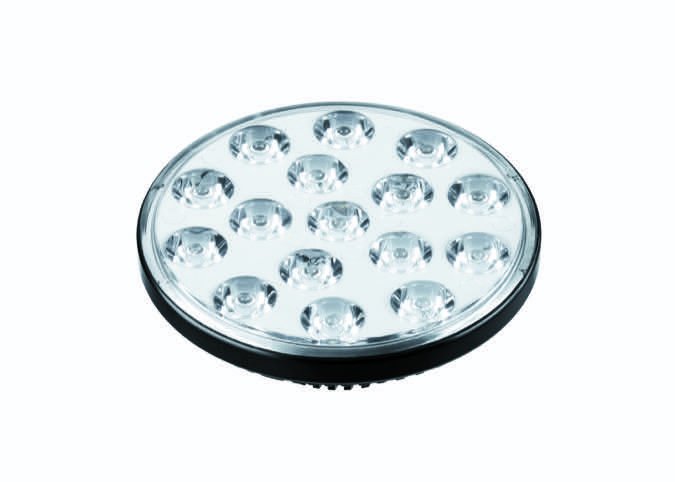
Given the low volume of new aircraft, we would peg the market driver for LEDs as the legacy fleet. Not necessarily, says AeroLEDs’ Wilkinson. The company does a fair amount of OEM business and recently became a supplier to Textron/Beechcraft and Pilatus. Wilkinson says these companies have switched to LEDs because—in both cases—subjective testing by company engineering and test pilots found them to be superior, even though the measured light output doesn’t necessarily equal claimed output for incandescents. What’s driving the legacy market? Probably an even mix of performance, durability and gadget lust. Wilkinson says there’s price sensitivity in the legacy market, but it’s hard to imagine that anyone shopping the web for a $10 GE4509 would suddenly be swayed by a $435 LED equivalent. Where owners find value, say the manufacturers, are in two areas. One, the lamps can realistically be considered lifetime purchases and since they can be turned on and left on, there’s a payoff in conspicuity. Adding to that is that most of the bulbs include a pulse or wig-wag feature that’s relatively easy to wire and activate. Then again, not everyone wants that.
“Our lights originally had a great deal of customization and flexibility in beam widths, wig-wag, taxi array, landing array…and a 50 percent intensity feature for helicopters operating in dust or snow,” says Aveo’s Rick Lindstrom. “We found that people were saying, ‘Wait a minute. I don’t want that. All I want is a light with two terminals that I can swap out,'” Lindstrom says. The company’s $895 Hercules Drop-In meets that brief. AeroLEDs has similar offerings, with the $339 Sunspot 36LX representing the lowest rung on the product ladder.
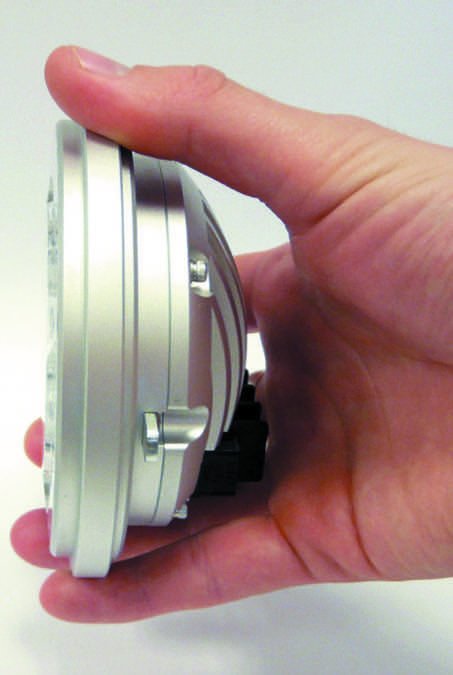
As the product chart shows, the market is highly stratified by price, with Aveo in the top tier, AeroLEDs occupying a broad middle with a diverse product line, and Whelan and Teledyne at the bottom with sub-$300 offerings that don’t have wig-wag, pulsing or intensity controls. For those companies—at least Whelan—product revision has consisted of upgrading when the next generation of LEDs appear. “As a general rule of thumb, we’ll maintain a design for five to six years. We’re also at the mercy of the manufacturers of LEDs because aviation is a very small user of LEDs,” says Jeff Argersinger, Whelen’s director of aviation sales.
Whelan, he says, buys some 65 million LEDs a year across its high-volume product lines in vehicle lighting, so it has a good feel for what improvements are coming. Cree Inc. is the dominant supplier of LED components and manufacturers try to keep abreast of what it’s about to introduce. But, as with all things in aviation, it’s not that easy.
“We can design optics for a certain size LED and now Cree comes along with an LED that’s the size of a pencil eraser. Now our optics don’t work with that. So now we need to design new optics. But if it’s a smaller LED, maybe we can use more and get more intensity and maybe run them at a lower current. You can maintain that sweet spot so you’re not over-driving them,” Argersinger says. And that’s exactly how Whelan got to the Parmetheus Plus, which is 40 percent brighter than what it replaces.
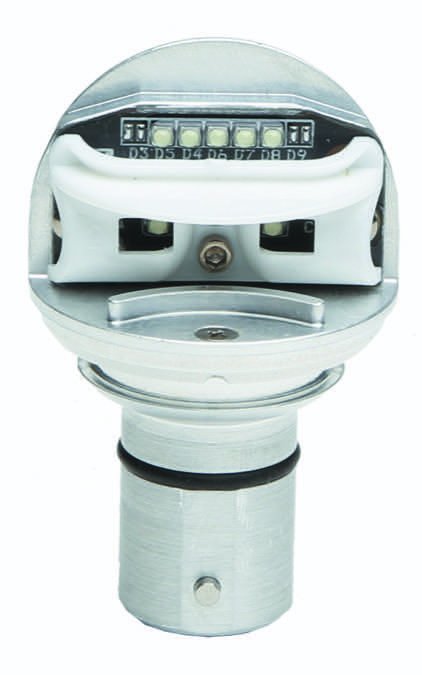
AeroLEDs has done essentially the same with its ever-expanding lines. The newest models are brighter than ever and offer drop-in for GE’s 4596, 4587, 4580 and 4554 bulbs. On its website, AeroLEDs has a long list of approvals and applications covering just about every mainstream landing light. Like Aveo and Whelen, it has approved navigation and position lights, which we’ll cover in a future issue.
Brightness Explained (Sort Of)
Compared to realistically evaluating specs on light output, nailing Jell-O to the ceiling is relatively easy. That’s because there appears to be no agreed-upon method of comparing light output from aircraft lamps of any sort. In the end, as Dean Wilkinson of AeroLEDs told us, a subjective judgment is as good as it gets.
First, a short essay on the differences between candela, lumens and lux. After a fashion, they’re all measurements of light energy, but like sound, light energy varies with distance from the source and it can be shaped and focused so angles matter, too. A candela—it’s the same as candlepower—is a measurement of luminous intensity. It’s directional and monochromatic. So a candela is the luminous intensity from a source of 1/683 watt per steradian. If you don’t know what a steradian is, don’t feel bad. It’s the standard international unit of solid angular measurement and allows light to be measured consistently in angular, three-dimensional space. A steradian is a cone shape that emanates from a sphere, the center of which is the light source.
A light source that uniformly illuminates one candela across one steradian is one lumen. That ought to clear things up, right? Don’t forget lux and it’s not the hotel in Las Vegas, either. A lux is equal to one lumen per square meter. The last time we measured landing light output (see Aviation Consumer, May 2015), we used a lux meter because that’s what we had available. Measuring candela would have been better, but was beyond our meager abilities. However, if everything is measured in lux, there’s at least some consistent basis for comparison.
Unfortunately, a buyer perusing the websites looking for equivalent consistency might not find it. That’s especially true when comparing LEDs to GE bulbs.

For example, the stalwart GE4509—the most common landing light—has a nominal rating of 110,000 candela. But it’s not necessarily clear how this was or is measured and two LED manufacturers told us they’re hard pressed to see 80,000 cd out of this bulb. And that degrades as the filament heats and sags out of the most efficient center part of the reflector.
When testing incandescent bulbs with a lux meter, we saw significant output variations between incandescent sources, even though we were careful to place the sensor consistently.
So what to make of candela claims by the LED manufacturers? In our view, not too much, because we don’t know if the measurements are done consistently by the companies. For example, for its Hercules Drop-In PAR 36, Aveo gives a color temperature, but no candela output. For its equivalent PAR 36, AeroLEDs gives 50,000 candela for the landing lens and 15,000 for the wider taxi lens. For its Parmetheus Plus, Whelan promises 60,000 cd for the landing light and 15,000 for the taxi version.
Does that mean the Whelan is the brightest? AeroLEDs and Aveo might argue the point and we might, too. As we’ve noted, color temperature matters. A lot. The warmer the temperature in degrees Kelvin, the closer the light is to daylight and the better it illuminates fine detail such as runway stripes and markings. In our experience, all the LEDs are better at this than traditional incandescents, no matter what their claimed brightness might be.
For this report, we weren’t able to assemble all the products for an informal light range test and subjective evaluation. We’ll do that in a future article.
Buy or Not?
Although we’re seeing new products and improved products for the same applications, the buying calculus remains the same, in our view. Despite a glut of LED manufacturing capacity, prices of aviation-related lighting aren’t likely to decrease much, if at all. We suspect the current three-tier price structure will endure for the foreseeable future.
As we’ve said before, the two best reasons to buy an LED landing light are conspicuity and freedom from frequent replacement. The lights can be left on without fear of failure. (Bulb life is claimed between 30,000 and 50,000 hours and we’re not hearing complaints about premature failures.) We’re less convinced that LED position lights are as cost effective because the incandescent versions don’t fail very often and the LED replacements are still expensive. We’ll take a look at that in a future report.





